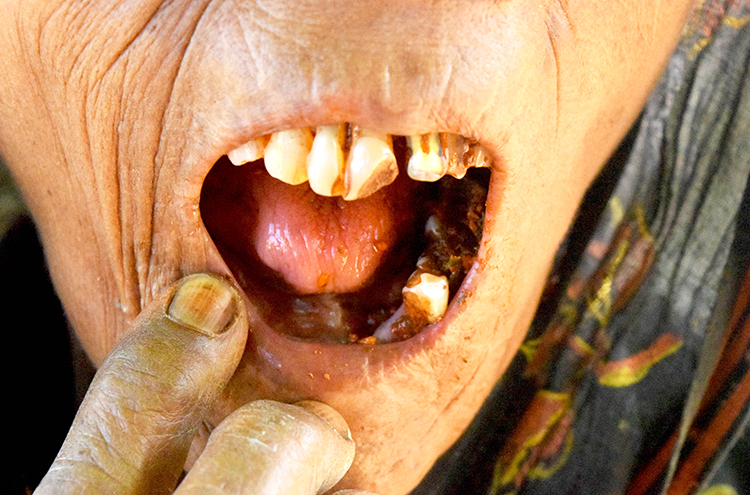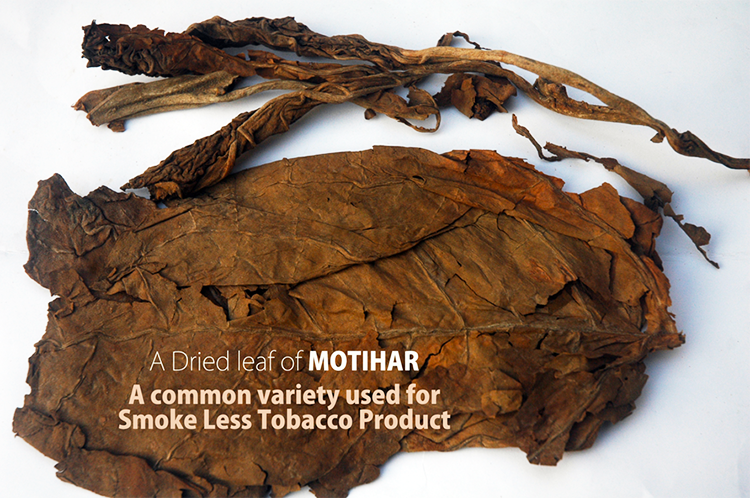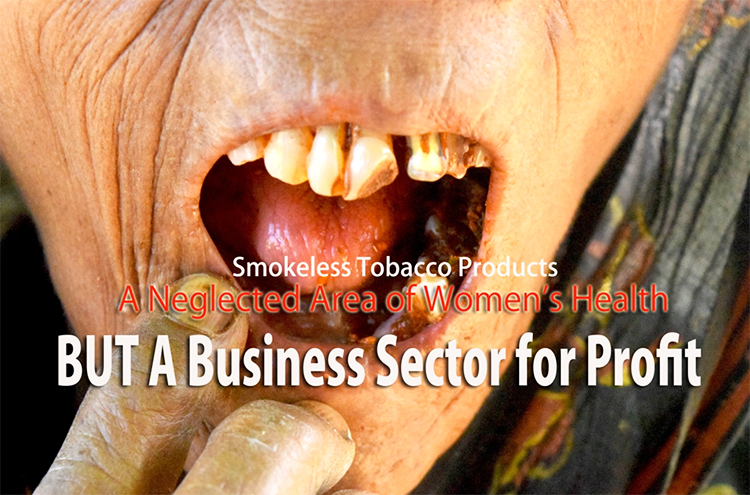Smokeless Tobacco Products Business & Women

UBINIG || Monday 28 September 2020 ||
UBINIG Factsheet 1 August 2020
Bangladesh has high consumption rate of smokeless or chewing tobacco. One in five (20.6%) of adult population (22 million) use smokeless tobacco such as Zarda, Gul, Khaini and Sadapata. Among adult women, tobacco use that is smokeless tobacco, is 24.8%, smoking rate is less than 1%. In contrast, use rate of smokeless tobacco among adult men is 16.2% while smoking is 36.2%. Overall among the 37.8 million tobacco users in the country, smokeless tobacco use is higher (20.6%) than smoking 18% (GATS, 2017).
The Smoking and Tobacco Use (Control) Act. 2005, amended 2013 has included three smokeless tobacco products (Zarda, Gul and sadapata) in the definition of tobacco products, bringing these under law to regulate their use.
Bangladesh ranks the third (after India & Nepal) highest smokeless tobacco use among 9 southeast and south Asian countries [Sreeramareddy CT, Pradhan PM, Mir IA, Sin S, 2014].
Forms of use of Smokeless tobacco
Most common form of smokeless tobacco used among adults is betel quid with tobacco (24.3%), followed by gul (5.3%), sada pata (1.8%), and khoinee (1.5%) (CTFK, 2019)
It has tobacco (Motihar variety Nicotiana Rustica). Zarda and gul have other ingredients including for attractiveness, addiction, additives, chemicals and other plant materials and thus becomes more socially acceptable as a non-tobacco product.

Like cigarette, smokeless tobacco, particularly Zarda used with betel quid has tobacco as the main ingredient. The Tobacco leaf variety is Motihar, Nicotiana Rustica, is native to Bangladesh and cultivated in the northern districts of the country.
Article 9 & 10: Ingredients must be disclosed
The Articles 9 and 10 WHO Framework Convention on Tobacco Control (FCTC) - on Regulation of the contents and disclosures of tobacco products requires guidelines for testing and measuring the contents and emissions of tobacco products and to disclose to governmental authorities information about the contents and emissions of tobacco products. Smokeless tobacco products, particularly Zarda are made palatable by adding spices, areca nut, sweeteners and scents to be taken with betel-quid. Chemicals and other ingredients in smokeless tobacco products, including non-tobacco plant material, can affect the attractiveness, addictiveness, and toxicity of the products.
Ingredients found in Zarda brands in Bangladesh
Ingredients for Attractiveness:
natural & artificial flavors & added perfume, natural and synthetic flavor, natural perfume
Toxicity ingredients: color, food color
Additives: Not mentioned
spices, molasses, cinnamon, menthol, saccharine, glucose, glycerine, vegetable oil, Gum Arabic, Mrigonavi to help create addictiveness
Non-tobacco Plant material : Papaya, Herbs, Joyfal, jostimodhu, saffron
BUT 62% of Zarda brands have no disclosure of Ingredients
Out of 109 brands of Jarda, ingredients names were available in only 37% (41 Zarda) brands. No information available for 67 brands of Zarda (62%). In some cases the printing is too small that it is not readable [UBINIG-Tabinaj, 2016]

Cheap and easily available: Zarda, Sadapata and Gul are available in any tea stall, vendours, in groceries, bazaars and even in the non-food shops such as crockeries shop. These are very cheap ranges from Tk. 5.00 ($0.06) for 5 gm to a maximum of Tk. 360 ($4.3) for 140 gm for zarda, Tk. 5.00($0.06) to a maximum to Tk. 8.00 ($0.09) for Gul, and Tk. 3.00 ($0.04) to Tk. 5.00($0.06). The general price variation for zarda for weight between 5 to 10 gram is Tk. 12 ($0.14 – 0.23) only. These are easily available in tea stalls, vendors and shops.
Women and Paan Zarda
A Tabinaj investigation of 288 users in 19 districts shows:
As consumption of betel quid with zarda is not a socially prohibited act, the starting age paan-zarda is low and is influenced by her socio-economic conditions.
Findings of Smokeless Tobacco User’s Survey
The users (288) in the survey were found to start at an early age of less than 20 years (43%); however the majority (79.5%) started between 20 to 30 years. This means, most women started using betel quid after marriage. About 14% started when they were over 31 years old. Very few (6%) women started over 40 years. Those who are current users they have been consuming paan with jarda/sadapata for over 20 years.
How they started? 47% started through serving paan to the elderly family members, mother, mother-in-law, grandmother. Mother-in-law plays more important role than own mother, because most start taking paan after marriage, at the insistence of the mother-in-law or through serving her. Only 4% got the habit before marriage through grandmas. 36% through other elderly famiy members like father, grandpa.
Economic condition of the users: 28.5% have monthly income of Tk. 2000 – 5000; 37.5% have income below Tk. 10, 000 and only 17% of the users earn over Tk. 10,000 per month. 47.6% of the users spend Tk.200 – 500 ; and over Tk. 500 by 28.5% users. The average spending on pan-zarda id Tk. 505, which is about 3 to 4 days income for the low income people earning below Tk.5000 per month.
80% started using tobacco between age 20-30 years; 47% learnt through serving elderly members (mother-in-laws]; mostly started as young married women
About 24% of users spend Tk. 200 – 500 per month only on Zarda, 46% spend Tk.50 – 200. The average monthly spending on Zarda-sadapata is Tk. 185 . The annual spending is Tk.2,220 which almost one month of half a month’s income of a low income person.
Company income from the sample 288 users per year is Tk. 639,360. (approx. 8000 USD)
Health effects: According to Dr Shakhawat Hossain, Oral and Maxillofacial Surgery physician, Bangabandhu Sheikh Mujib Medical University (BSMMU) consumption of tobacco products with betel leaf for long may end up in fatal diseases like cancer and chronic liver diseases. "Women can give birth to autistic children due to consumption of lead adulterated smokeless tobacco," said the doctor, adding they are now getting more patients with mouth cancer. [TBS Report]
No woman consumes Zarda for its addictive nature, but after long term consumption, she develops addiction.
Name & Price Effect On Use: Bau Shahzadi (wife-princess) Zarda
Shefa (23) a domestic help in Dhaka city, uses Bou Zarda because it has a sweet smell and the price is low. Shefa buys paan with Bau Zarda 5 times a day. Her monthly expenditure on Pan with Bau-Shahzadi Zarda is Tk. 400 (4 USD). It is packed in plastic container without any disclosure of the ingredients in it. No price is mentioned on the pack of this zarda.

Bau-Shahzadi Zarda is one of the 22 of the Zarda brands which contained heavy metals like lead, cadmium and chromium according to the Bangladesh Food Safety Authority (BFSA) [TBS Report] .
Company Tactics of exploiting socio-cultural acceptance and the poor
- Using feminine names: Tabinaj study of 371 brands showed use of female names and photos to attract women users in 38 brands (10%). These names included Ratna, Surovi, Salma, Laboni, Shova, Shahzadi (princess), Rashida, bou (wife) – common and attractive female names. This attracts both men and women. Women are attracted by nice photos.
- Low quality packaging and lower price.
- Attractive and scented ingredients: natural & artificial flavors & added perfume, natural and synthetic flavor, natural perfume. Tabinaj study on 109 brands showed 41 brands having perfume, flavours, scented ingredients.
- Promoting attractive betel quid containers – paan dan, family occasions, collective consumption
- Offering free additional for buying two packs as well as price discounts.
Dominating Zarda brand in the market
Case of Hakimpuri Zarda
Hakimpuri Zarda is one of the most “popular” Zardas in the market popular among users across the country. The company Kaus Chemical Works Ltd. offers discount of upto 2.5 million BDT (30,000 USD) for a turnover of the brand at an amount of 40 to 50 million (47 to 48,00,000 USD).
The owner Haji Mohammad Kaus Mia, has different business ventures. Hakimpuri Zarda is one of them, since 1978. Kaus Mia has been awarded 4 times by the National Board of Revenue as a top taxpayer and received Tax card (Sujan Mia) which enables him to receive various government priority facilities as a tax card holder. "Questions are often raised why the large businessmen are not getting tax cards when a jarda (smokeless tobacco) selling businessman, Kaus Mia, is getting the highest taxpayers award."[FE Report]

Among many others, the most popular brand, Hakimopuri Zarda, does not disclose the ingredients on the package of Zarda it sells thge most. It says only, “sade-Gondhe” – a deceptive promotion of taste and smell that comes from the use of ingredients.
Hakimpuri Zarda is exported to USA from Bangladesh, in 25 CTN (Carton quantity)(as of August 31, 2013 https://www.zauba.com/import-zarda-hs-code.html total value $4036. ZAUBA Technologies private Limited is involved this venture. Zauba Technologies Private Limited is an Indian company, Galaxy, No 43, Residency Road, Bangalore - 560 025
In 2019 a case was filed against Hakimpuri Zarda at Pure Food Court of Dhaka South City Corporation (DSCC), as heavy metals like lead, cadmium and chromium was found in it.
Bangladesh Food Safety Authority (BFSA) has collected different types of zarda, a smokeless tobacco, in two phases and tested these in lab where it was revealed that the 22 zarda products contain heavy metals. Per kilogram of Hakim Pury products have 26 milligram of lead, 0.95 milligram cadmium and 1.65 milligram of chromium, according to the food safety authority. [TBS Report] Since this product contains high levels of heavy metal, they should be banned.
International Business Portals
Tobacco1.com, the international portal for worldwide Tobacco Industry and an active business-to-business website for all Tobacco Suppliers and their products deals with 921 chewing tobacco suppliers. https://www.tobacco1.com/ From Bangladesh, they supply 10,000 pieces of 12 chewing tobacco brands at a price of 1$ /piece.
The 12 brands of zarda exported are: 1. Hakim Pury Zarda 2. Shova Zarda 3. Chaman Bahar, 4. Pan Parag Paan Masala, 5. Momo Zarda, 6. Jay Gopal Zarda, 7. Ezma Zafran Zarda, 8. Bharati Zafrani Zarda, 9. Bat One Baba Zarda, 10. Nurani Red Leaf Zarda, 11. Nurani Shahzadi Zarda, and 12. Akij Zarda.
The ingredients disclosed are: Tobacco, glycerin, menthol, perfume and various spices https://www.tobacco1.com/tobacco-products/zarda-1
One does not know if they are disclosing any harmful chemical used in those Zarda.
The global data of EximPulse.com of 62 countries, https://www.eximpulse.com/export-product-zarda-country-BANGLADESH.htm shows Bangladesh exporting 3 brands of zarda such as Tulshi Zarda, Gopal Tobacco and Zarda A.P. I exported through Bangladesh-India land border of Benapole and loaded on Petrapole, the Indian land border on the otherside. Among the 10 items of import listed in Petrapole Land Port Authority of India, zarda is not listed; only betel nut is listed. http://www.lpai.gov.in/content/innerpage/icp-petrapole.php
Other business entities in Export & Import such as Zauba https://www.zauba.com/ is engaged in exporting zarda from Bangladesh to USA and other destinations. Countries such as the USA have strict standards regulating products with heavy metal. It is unclear how these products pass the USA standards.
Conclusion
Zarda as a Smokeless tobacco product is under the national tobacco control law, but its supply side is completely unregulated and the companies are taking advantage of social & cultural acceptance; thereby expanding their market at national and international level. As a result, at the national level women are exploited as workers in the cultivation of the leaves, zarda production in the factories and as consumers. At the international level, overseas women workers, expatriates in Europe, US, Canada and other countries are affected with health impacts through exports of zarda by the international companies.
Recommendations
1. The national tobacco control law must be effectively implemented for regulation of use of smokeless tobacco. The companies must disclose ingredients containing harmful chemicals following Articles 9 & 10 of FCTC.
2. The production of zarda from leaf production to zarda manufacturing must be brought under licensing and registration.
3. The export of smokeless tobacco must be brought under the national Export regulations imposing export duties.
4. Women as workers in the zarda leaf production, zarda factories and as users must be protected against health hazards and against discriminations in wages.
References
GATS, 2017: Global Adult Tobacco Survey, Fact Sheet Bangladesh 2017, MOHFW, government of Bangladesh, WHO, CDC and BBS, 7 Aug 2018
CTFK, 2019: Smokeless Tobacco: Bangladesh, Fact Sheet, 2019 Campaign for Tobacco-free Kids, CTFK, Washington
WHO, 2014: Fact Sheet on “Ingredients in tobacco products” WHO 2014
EU, 2010: Addictiveness and attractiveness of tobacco additives. European Union Scientific Committee on Emerging and Newly Identified Health Risks (SCENIHR). Brussels: European Union; 2010 (http://ec.europa.eu/health/scientific_committees/emerging/docs/scenihr_o_031.pdf).
UBINIG-Tabinaj, 2016: Ingredients in Smokeless Tobacco Products, prepared for Strategy paper work on smokeless tobacco products in Bangladesh
UBINIG-Tabinaj investigation, 2017 : A study in 19 districts on women users of Zarda, 2017
TBS Report: “Hakim Pury Zarda to be removed from market for metal presence” TBS Report, The Business Standard, 8 December, 2019, Dhaka Bangladesh https://tbsnews.net/bangladesh/hakim-pury-zarda-be-withdrawn-market
FE Report: NBR facilitates tax payment thru' MFS: Tax fair starts, The Financial Express Published: November 13, 2019, Dhaka, Bangladesh https://thefinancialexpress.com.bd/trade/tax-fair-starts-thursday-1573620185
Sujan Mia : Highest taxpayer for four times: Pay taxes, do business honestly: Kaus Mia, The Asian Age, 04 November 2016 https://dailyasianage.com/news/36555/pay-taxes-do-business-honestly-kaus-mia
Sreeramareddy CT, Pradhan PM, Mir IA, Sin S. Smoking and smokeless tobacco use in nine South and Southeast Asian countries: prevalence estimates and social determinants from Demographic and Health Surveys. Popul Health Metr. 2014;12:22. Published 2014 Aug 28. doi:10.1186/s12963-014-0022-0
This fact sheet was supported by the STOP project, an initiative of the Bloomberg Philanthropies
Produced by UBINIG (Policy Research for Development Alternative), a policy research and campaign organization in Bangladesh. It has worked jointly with TABINAJ – the Alliance of women against Tobacco formed with more than 100 women’s organizations in 64 districts of the country.
Address: Huq Garden, Apt# 4AB, 1 Ring Road, Shaymoli, Dhaka-1207, Bangladesh; e-mail: info@ubinig.org
Tel: 88-0258155015, website: www.ubinig.org; facebook https://www.facebook.com/UBINIG/

https://ubinig.org/pdf/229.pdf